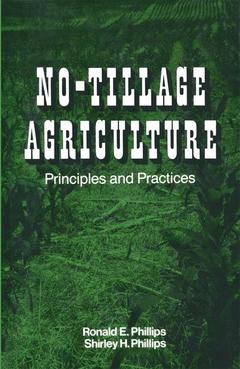No-Tillage Agriculture, Softcover reprint of the original 1st ed. 1984 Principles and Practices
Langue : Anglais
Auteurs : Phillips Ronald E., Phillips Shirley H.

No-tillage cropping systems and concepts have evolved rapidly since the early 1960s and are attracting attention worldwide. The rapid growth and interest is associated with increasing pressures for food production from a fixed land resource base with degrading effects of erosion, soil compaction and other factors becoming more noticeable. Research programs have provided many answers and identified new technology needed for success of the no-tillage crop production system in the past two decades and this has resulted in a rapid rate of adoption. Farmers played an important role in the early stages· of development of the system and continue to play an important role in its improvement and rapid rate of adoption. This book provides an inventory and assessment of the principles involved in no-tillage concepts and addresses the application of the technology to practical production schemes. Selected authors and contributors have long been associated either in no-tillage research or application. They represent many disciplines interfacing with the complex interactions of soil, plant and environment. Personal obser vations by the authors in many geographic sectors of the world indicate the principles to be valid but application of the principles to be less uniform. The application of no-tillage principles requires considerable modification as variations in soil and/or climatic condi tions are encountered in different regions of the world.
1. Introduction.- Reasons for Tillage.- Factors that Contributed to the Increased Interest in No-Tillage Systems.- Advantages of No-Tillage.- Disadvantages of No-Tillage.- Present Philosophy in No-Tillage.- 2. Effects of Climate on Performance of No-Tillage.- Precipitation and Evapotranspiration.- Soil Temperature.- Corn Seedling Growth as Related to Soil Temperature.- Time of Planting.- 3. Soil Adaptability for No-Tillage.- Some Factors Affecting Adoption of No-Tillage 42 Soil Drainage.- Suitability for Sloping Land.- Soil Water Erosion.- Erosion Control by No-Tillage.- Controlling Soil Wind Erosion by No-Tillage.- Steeplands.- 4. Soil Moisture.- Effect of Mulch on Evaporation of Soil Water.- Effect of Soil Texture, Pans and Drainage Class on Soil Water Evaporation.- Soil Water in Field Studies.- Effect of No-Tillage on Root Growth.- 5. Fertilization and Liming.- The Soil Environment Under No-Tillage Versus Conventional Tillage.- Nitrogen Requirements for No-Tillage Crops.- Pathways of Nitrogen in the Two Systems.- Methods of Nitrogen Application.- Phosphorus Requirements.- Potassium Distribution and Availability in the Soil.- Soil Acidity and Lime.- Sulfur.- Micro nutrients.- Role of Cover Crops in Nitrogen Fertilization of No-Tillage.- 6. Energy Requirement in No-Tillage.- Energy Use in Agriculture.- Need for Energy Conservation in Agriculture.- Energy Use and Efficiency in Tillage Systems.- Tillage Operations.- Planting.- Field Machinery.- Seeding Rates.- Weed Control.- Comparison of Tillage System.- Energy Efficiency in Fertilizer Management.- Tillage and Nitrogen Fertilizer Efficiency.- Time of Application and Nitrogen Fertilizer Efficiency.- Effect of Fertilizer Placement on Efficiency.- Nitrogen from Legume Cover Crops.- Energy Efficiency in Forage Production.- 7. Response of Weeds and Herbicides Under No-Tillage Conditions.- Some Factors Affecting Weed Control in No-Tillage.- Effect of Surface Plant Residue on Herbicide Persistence.- 8. Other Pests in No-Tillage and Their Control.- Insects.- Soil Insects.- Above-Ground Insects.- Diseases.- Corn.- Sorghum.- Soybeans.- Wheat.- Summary.- 9. Changes in Soil Properties Under No-Tillage.- The Microbial Environment.- Number and Activity of Soil Microorganisms.- Tillage Effects on Soil Animals.- Decomposition of Organic Matter.- Mineralization and Immobilization of Nitrogen.- Effects of Tillage on Nitrification and Denitrification.- Soil Physical Properties.- Influence of Mulches on Soil Physical Properties.- Effect of Tillage on Soil Density and Porosity.- Chemical Properties.- Phosphorus and Potassium.- Magnesium.- Summary of Chemical Properties.- 10. Multicropping.- Multicropping With No-Tillage Techniques.- Beginnings of Multiple Cropping in the United States.- Requirements for Successful Multiple Cropping.- Length of Growing Season.- Water.- Weed Control.- Fertilizer Practices.- Equipment.- Management of Multiple Cropping.- Profitability of Multiple Cropping.- The Future of Multiple Cropping.- Winter-Summer Double Cropping.- Summer-Summer Double Cropping.- Winter-Summer-Summer Double Cropping.- Other Multiple Cropping Systems.- External Factors Affecting Profitability of Multiple Cropping.- Combining Agronomic Practices for Multicropping on Sloping Land.- 11. Equipment.- Planters and Planting No-Tillage.- Types of Planters.- Tractor Requirements for No-Tillage.- Pesticide Applicators.- Hand Planting.- 12. No-Tillage in the Tropics.- Soil Resources.- Distribution and Classification of Tropical Soils.- Properties and Characteristics of Tropical Soils.- Soil Fertility.- Erosion Problems.- Water Resources.- Climatic Conditions in the Tropics.- Soil Moisture Storage and Water Use.- Conservation of Water Using No-Tillage.- Human Resources.- Availability of Labor.- Other Sources of Energy.- Acceptance of New Technology.- Management Ability.- Prospects for Success of No-Tillage in the Tropics.- Small Farmers and Large-Scale Farmers.- Soil Conservation.
Date de parution : 04-2012
Ouvrage de 306 p.
15.2x22.9 cm
Disponible chez l'éditeur (délai d'approvisionnement : 15 jours).
Prix indicatif 105,49 €
Ajouter au panierMots-clés :
© 2024 LAVOISIER S.A.S.



